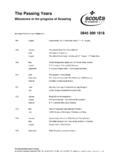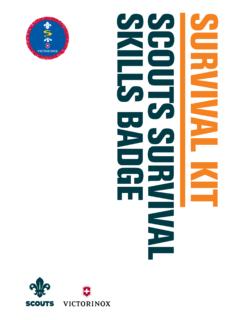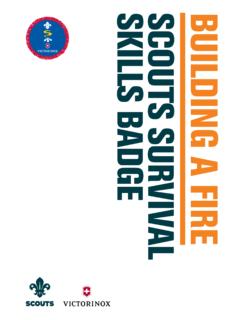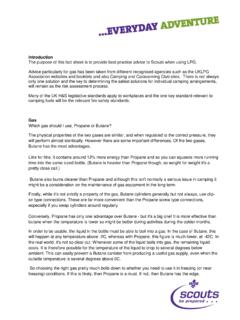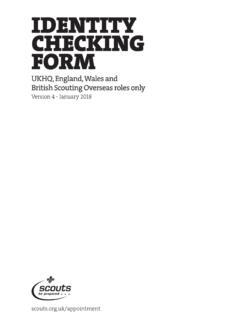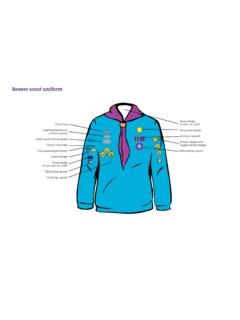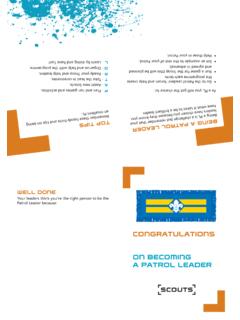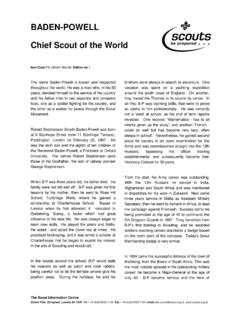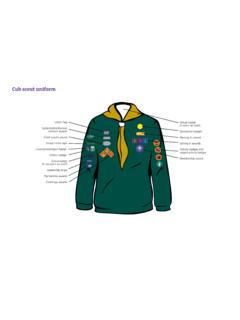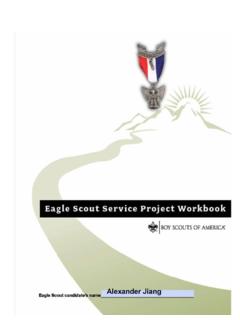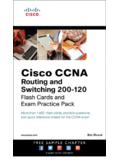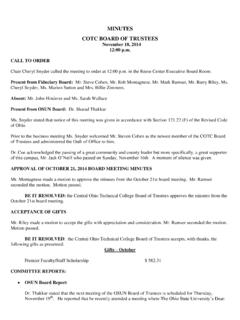Transcription of KNIFE SAF - Scouts
1 KNIFE SAFETYSCOUTS SURVIVAL SKILLS BADGECONTENTSPage 3 IntroductionPage 4 6 Knives and the law Page 7 6 Types of Knives Pages 8 11 Swiss Army KnifePages 12 Safety dos and don tsPage 13-15 Cleaning and maintenancePage 16-18 Activity sheetsTHANKS TOAustin LillTerry LonghurstPablo22nd Hampstead Sea scout Group15th Chingford scout Groupfor their contributions to this resourcePhotography, Paul Kirtley pages 14/15 March 2015 The scout Association. Registered charity numbers: 306101 (England and Wales) and SCO38437 (Scotland)23 scout Survival Skills: KNIFE safety@ PACK ACTS AS A REFERENCE FOR Scouts AND scout LEADERS ON KNIFE SAFETY, KNIFE LAW AND MAINTENANCE. Scouts MUST COMPLETE THE ACTIVITIES AT THE END OF THE PACK TO SHOW THEIR UNDERSTANDING OF THESE AREAS. ANY PRACTICAL ACTIVITIES SHOULD BE COMPLETED UNDER SUPERVISION FROM scout LEADERS OR BUSHCRAFT scout Association is delighted to be working in partnership with global brand Victorinox, makers of the iconic Swiss Army KNIFE and suppliers of essential tools for millions of adventurers and pioneers around the world.
2 Swiss Army Knives are essential tools in every scout s survival kit. We are proud to have Victorinox as our partner for the scout Survival Skills Badge, which encourages adventurous activity and educates Scouts in how to be prepared for emergency situations in the scout Association recognises that bladed and sharply pointed hand-tools are important for working on survival skills. We promote the safe use of knives used as a tool reiterating UK Law. Knives with a fixed non-folding blade, a folding KNIFE with a blade over 3 inches in length or a folding KNIFE which locks in place require the person carrying such a KNIFE in public (whatever age) to have good reason for carrying the tool. It is illegal to sell such a tool to a person under 18. The scout Association holds no responsibility from injuries that have occured as a result of using this resource.
3 Whenever a KNIFE is to be used in an activity a risk assessment must be made and suitable controls put in the outdoors in a safe way is an ethos shared by The scout Association and Victorinox. The partnership aims to emphasise and educate young people on the importance of KNIFE safety, giving them the opportunity to learn about responsible ownership when using a KNIFE in Scouting. This new resource has been developed with Victorinox and scout Leader bushcraft experts. It aims to give Scouts all the information and guidance they need when working towards their scout Survival Skills badge, including KNIFE safety, how to build a fire and shelter from natural resources, administering emergency first aid and signalling for assistance in a survival situation. The final part of the badge requires Scouts to put together their own survival kit as well as plan and take part in an overnight survival AND VICTORINOX DISCLAIMER4 scout Survival Skills: KNIFE safety@ AND THE LAWIF YOU ARE USING A KNIFE OUTDOORS, IT IS ESSENTIAL YOU UNDERSTAND WHAT YOU ARE LEGALLY ALLOWED TO DO AND THE PENALTIES IF YOU DO NOT ADHERE TO THE , SELLING OR CARRYING KNIVES It is illegal to.
4 Sell a KNIFE of any kind (including cutlery, kitchen knives or Swiss Army Knives) to anyone under the age of 18 (in England, Northern Ireland and Wales) although 16 to 18 year olds in Scotland can buy cutlery and kitchen knives carry a KNIFE in a public place without good reason or lawful authority (for example, a good reason is a chef on his way to work and carrying his own knives) carry a foldable, non-locking KNIFE , like a Swiss Army KNIFE , in a public place unless the blade is shorter than three inches ( ) use any KNIFE in a threatening way, even a legal KNIFE such as a Swiss Army KNIFE A lock blade KNIFE is one where the blade stays open unless some mechanism is used to close it. These are also illegal to carry. However, from a safety point of view a lock blade KNIFE cannot fold on to the user s fingers and may be better for use in some Scouting sure you do not carry a KNIFE that is illegal and exceeds the stated size limit.
5 The police are unlikely to accept your explanation that you are simply using the KNIFE in the outdoors. An adult caught carrying an illegal KNIFE in public currently faces a maximum fine of 5,000 and four years in prison. For more information go to: a campsite may technically be private property, even if owned by a district or a county, it s considered as public property and KNIFE law applies to these areas the Criminal Justice Act 1988 at: following information is correct as of March 2015. It is the responsibility of the person undertaking the task to check for up to date information on KNIFE INFORMATION THE SAFETY BASICSS afety FirstA KNIFE is a tool and should be treated as you are going to use a KNIFE then you should receive training from your leader or an expert on how to use it safely.
6 Knives can be dangerous, so great care should be taken when using them. Safety check using a knifeOnly use a KNIFE for the purpose for which it was designed, and only carry one when it s needed for a job. Make sure your KNIFE and all it s tools are in good working order before you begin using it (see cleaning and maintenance).Work area safetyMake sure that you work within a clearly defined area. Ensure the people around you are aware of what you are doing so that no one could be accidently hurt with the KNIFE . Your work area should be clear from branches or undergrowth that may cause an accident. Tie back long hair and make sure any loose clothing is tucked in. The main UK legislation regarding the possession of knives and other sharply pointed/bladed objects is the Criminal Justice Act 1988.
7 This details what s generally deemed to be an offensive weapon, and Section 139, in particular, describes the types of knives that are banned and those that can be carried in public (and under what circumstances).5 scout Survival Skills: KNIFE safety@ to hold the knifeA KNIFE should be held firmly but not too tightly. Your hand should not be too far back or too far forward. Grip the KNIFE so that some of the handle can be seen where it meets the blade. If you are making smaller cuts or carving you can also place your thumb on the back of the blade which gives you more you start using your KNIFE , ensure you have a first aid kit and it is within your reach, but is not an obstruction to your working to make a cutting safelyWhen cutting a piece of wood with a KNIFE you should always cut away from yourself.
8 Think about where the KNIFE may go if it happens to slip before you make a cut. Grip the handle correctly then holding a piece of wood out to your side (see how to sit when carving or cutting), move the blade down then out, letting your shoulder rather than your arm do the work. You will use different cutting techniques for different blades, which is covered in the next section. Carrying or passing a knifeAlways return a KNIFE to its sheath, holder or folded position after use and when passing it to another person. Carry Swiss Army Knives with the blade folded away and never carry a fixed blade KNIFE that isn t in a injuryFollowing safety instructions will help you to avoid injury. If you do injure yourself with a KNIFE you will need to be aware of how to administer first aid.
9 Refer to the First Aid information sheet for more advice. How to sit when carving or cuttingYou should sit down on a solid surface with feet slightly more than a shoulder width apart. You should carve or cut in front of you with your elbows on your knees, well away from your thighs and body or to the side well away from yourself and others. If you cannot sit on a solid surface then sit in a kneeling position and carve or cut to the side, resting the lower arm that is holding the work piece on the outside of your thigh. Make sure that you are sitting away from others or that they are at a safe distance from Survival Skills: KNIFE safety@ can find up to date information on travelling abroad by plane and carrying knives in your luggage on the Government website: You should also check with your travel provider on luggage restrictions.
10 SAFETYS torageStore your KNIFE in a clean and dry place out of the reach of small children. When storing a Swiss Army KNIFE or any other tool with a folding blade, store it with the blade folded with a knifeDuring training, knives should be taken to and from scout meetings by an adult. When taking a KNIFE to camp it should be put in its own protective sleeve or pouch and securely stored in the middle of a rucksack or your KNIFE abroadIf you are travelling to a scout camp or jamboree, familiarise yourself with the local and international government laws for that country and the regulations around carrying tools with a KNIFE on them. Do not carry tools in hand luggage when travelling on an aircraft but pack them securely in hold luggage to avoid confiscation or getting into trouble with security checks.
